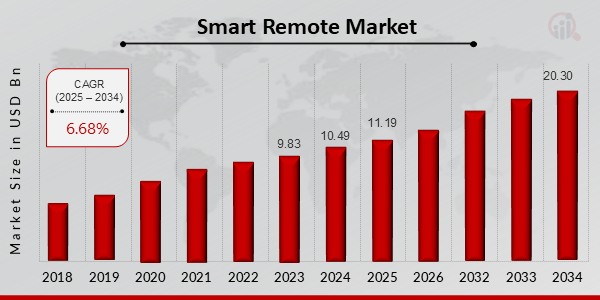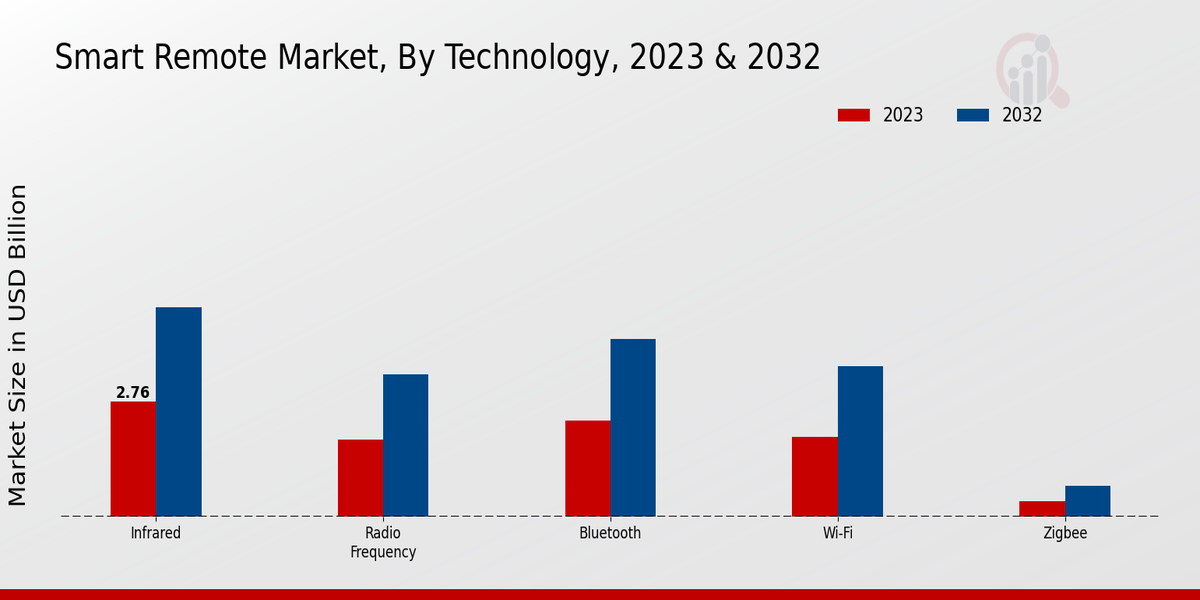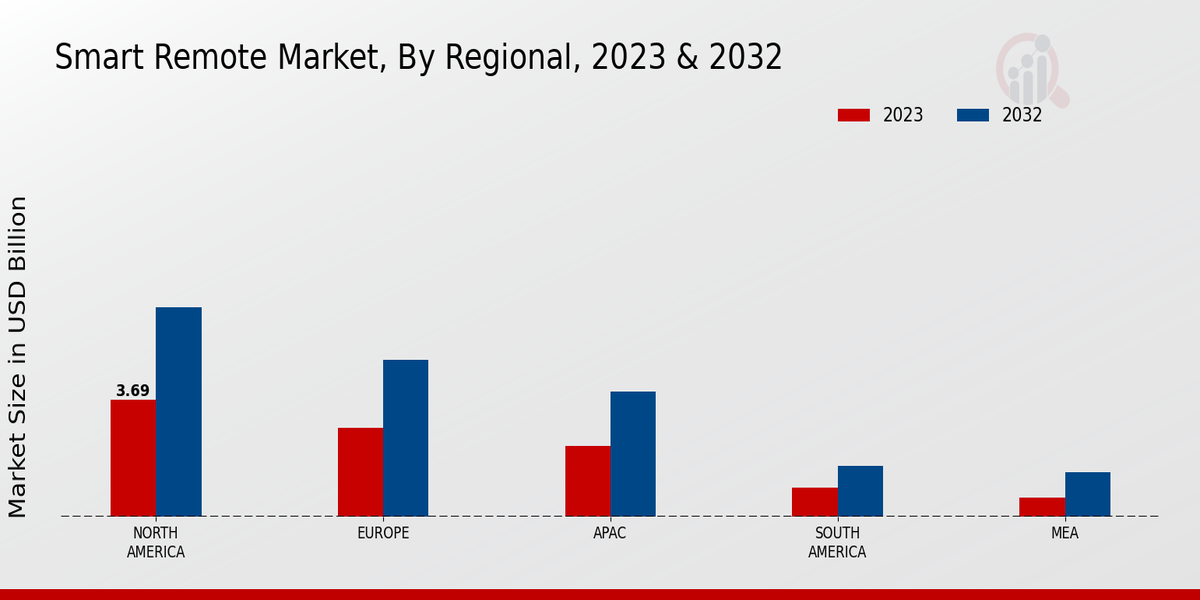Smart Remote Market Overview
Smart Remote Market is projected to grow from USD 11.19 Billion in 2025 to USD 20.30 Billion by 2034, exhibiting a compound annual growth rate (CAGR) of 6.68% during the forecast period (2025 - 2034). Additionally, the market size for Smart Remote Market was valued at USD 10.49 billion in 2024.
Key Smart Remote Market Trends Highlighted
The smart remote market is significantly driven by the rising adoption of smart home devices and the growing demand for integrated technologies that enhance convenience and control. Consumers are increasingly seeking ways to streamline their home automation processes, leading to a surge in the development and adoption of smart remotes that can interact with multiple devices simultaneously. As technology continues to advance, these remotes are becoming more user-friendly, featuring intuitive interfaces and advanced connectivity options such as Wi-Fi and Bluetooth. The proliferation of smart TVs and connected entertainment systems further fuels this growth, as users desire a singular control point for their diverse devices.
There are numerous opportunities to be explored within the market, particularly as consumers become more aware of energy efficiency and smart technology solutions. Manufacturers can focus on creating eco-friendly smart remotes that not only reduce energy consumption but also appeal to environmentally conscious consumers. Moreover, the integration of artificial intelligence into smart remotes presents a chance for businesses to innovate and enhance user experiences through personalized control settings and voice recognition capabilities. Collaborations with other smart home device manufacturers can lead to the development of solutions that allow seamless interoperability among various devices, which will likely capture a broader audience.
Recent trends indicate a shift towards compact and multifunctional designs that cater to the growing demand for minimalistic solutions. The inclusion of features like touch screens, customizable buttons, and programmable presets is gaining traction. Additionally, remote management through mobile applications is becoming more prevalent, allowing users to control their devices from anywhere. The rise of smart home technology is continuously shaping consumer preferences, driving the need for smarter, more efficient remote solutions. Overall, the ongoing evolution of consumer electronics is expected to keep propelling the smart remote market forward as integration becomes a benchmark for user satisfaction.
Figure 1: Smart Remote Market Size, 2025-2034 (USD Billion)

Source: Primary Research, Secondary Research, MRFR Database and Analyst Review
Smart Remote Market Drivers
Increasing Adoption of Smart Home Technology
The surge in the adoption of smart home technology is a critical driver for the Smart Remote Market Industry. As consumers become more tech-savvy and seek convenience in their everyday lives, there is an increasing preference for smart devices that can remotely control various home appliances such as lights, thermostats, and security systems. The integration of smart remotes with different home devices enhances user experience by allowing seamless control from a single interface.
Furthermore, advancements in Internet of Things (IoT) technology have facilitated improved connectivity and communication between devices, encouraging consumers to invest in smart remote solutions. With an escalating number of households transforming into smart homes, the demand for multifunctional and user-friendly smart remotes is expected to grow significantly. Companies are increasingly focused on developing innovative smart remotes that can adapt to a variety of platforms and ecosystems, which prompts greater consumer interest and adoption.
In addition, the growing emphasis on energy efficiency and automation in homes aligns with the capabilities of smart remote technology, making them essential tools for modern living. This shift towards smart living not only enhances convenience but also promotes a sustainable lifestyle, which is a key factor propelling the growth of the Smart Remote Market.
Rise in Consumer Demand for Integrated Connectivity
A notable driver in the Smart Remote Market Industry is the rising consumer demand for integrated connectivity across devices. Users are increasingly seeking solutions that allow them to control multiple devices from a centralized platform, which smart remotes can provide. As manufacturers continue to innovate and produce remotes that are compatible with various smart devices and ecosystems, consumers are drawn toward options that enhance their home automation experience.
This trend significantly influences market growth as consumers look for products that offer both ease of use and versatility.
Growing Popularity of Voice Control Systems
The growing popularity of voice control systems is another significant driver for the Smart Remote Market Industry. With advancements in voice recognition technology, users are gravitating towards smart remotes that can be operated through voice commands. This convenience aligns with the increasing reliance on virtual assistants and smart speakers in homes. The integration of voice control capabilities into smart remotes not only simplifies user interaction but also appeals to tech-savvy consumers looking for modern solutions, driving further demand in the market.
Smart Remote Market Segment Insights
Smart Remote Market Technology Insights
The Smart Remote Market presents a diverse landscape, particularly within the Technology segment, which is significant in shaping consumer electronics and smart home ecosystems. The overall market was valued at 9.22 USD Billion in 2023 and is projected to experience growth, reaching a value of 16.51 USD Billion by 2032. The market is characterized by its various technology types, including Infrared, Radio Frequency, Bluetooth, Wi-Fi, and Zigbee, each playing a vital role in the evolution of smart remote controls. Among these technologies, Infrared holds a substantial market position with a valuation of 2.76 USD Billion in 2023, emphasizing its widespread use in traditional TV remotes and basic device control, rendering it deeply embedded in the consumer electronics market.
The importance of Radio Frequency, with a value of 1.85 USD Billion in 2023, lies in its capability to facilitate connections over longer distances, making it a preferred choice for remote controls in various smart home applications. Bluetooth technology, valued at 2.31 USD Billion in 2023, is increasingly relevant due to its capability to establish secure connections with mobile devices and peripherals, enhancing user experience through easy pairing and connectivity. Wi-Fi, with a market value of 1.92 USD Billion in 2023, plays a significant role in smart remotes by enabling users to control their devices from virtually anywhere within their home, pushing the limits of remote capabilities and interconnectivity.
Finally, Zigbee, although smaller in scale with a valuation of 0.38 USD Billion in 2023, offers advantages in low power consumption and reliable mesh networking, catering primarily to smart home applications where multiple interconnected devices are prevalent. The continued advancement in these technologies will drive market growth, influenced by consumer demand for streamlined automation and control systems in household environments. As such, understanding the Smart Remote Market segmentation reveals how these various technologies hold significance individually while contributing to a robust market framework collectively, thereby shaping the overall landscape of smart device interaction and home automation trends.

Source: Primary Research, Secondary Research, MRFR Database and Analyst Review
Smart Remote Market Type Insights
The Smart Remote Market has shown noteworthy growth, with a valuation reaching 9.22 USD Billion in 2023, reflecting increasing consumer demand for advanced remote control options. The market segmentation highlights various types, including Universal Remotes, Single Device Remotes, Smartphone Remotes, and Voice-Controlled Remotes. Universal Remotes have become significant, allowing users to operate multiple devices from one remote, enhancing convenience and integration. Single Device Remotes serve specific devices, catering to niche markets and ensuring user simplicity.
The rise of Smartphone Remotes is notable as mobile applications allow users to control devices directly from their smartphones, reflecting a shift towards mobile technology. Voice-Controlled Remotes are gaining traction, driven by advancements in smart home technology, enabling users to interact seamlessly with their devices. With these dynamics shaping the Smart Remote Market, industry growth is propelled by increasing technological advancements and a rise in smart home adoption, presenting ample opportunities while addressing the challenges of market competition and customer preferences.
Expanding capabilities across these types represent the ongoing evolution in consumer electronics and user experiences.
Smart Remote Market End-Use Insights
The Smart Remote Market is positioned to witness significant growth within the End-use segment, projected to reach a valuation of 9.22 billion USD in 2023. This sector encompasses various applications that cater to diverse customer needs, including Residential, Commercial, and Industrial uses. The Residential segment tends to dominate this market, attributed to the increasing adoption of smart home devices, allowing consumers to integrate various home automation systems for enhanced convenience and energy efficiency. Meanwhile, the Commercial sector is gaining traction as businesses seek smarter control solutions for better operational efficiency and user experience.
Additionally, the Industrial segment is also noteworthy, with its utilization in managing complex systems and processes, contributing to overall productivity enhancement. Factors such as the surge in IoT adoption, the growing demand for integrated technology solutions, and improvements in user interface design are driving the market growth. Nevertheless, challenges remain, including issues related to interoperability and connectivity. The segmentation of the Smart Remote Market underscores the diverse application landscape and highlights the critical role of these sectors in shaping the industry's future dynamics.
Smart Remote Market Compatibility Insights
The Compatibility segment of the Smart Remote Market demonstrates robust growth driven by rising consumer demand for integrated control solutions across multiple device categories. The market revenue in 2023 was valued at 9.22 billion USD and is projected to grow significantly over the coming years. In particular, compatibility with Televisions and Smart Home Devices accounts for a considerable share as consumers increasingly seek to manage their entertainment and automation systems seamlessly. Audio Equipment compatibility also plays a crucial role, enhancing the user experience through unified control, while Gaming Consoles represent a vibrant demographic demanding technological integration.
As home entertainment systems evolve, the potential for advancements in the Smart Remote Market industry remains promising, offering opportunities for innovation in functionality and design. Market growth in this segment is driven by the increasing adoption of smart technology and internet connectivity in everyday devices, presenting a favorable landscape for manufacturers and developers. Overall, the Smart Remote Market data reflects a dynamic interaction among these categories, positioning them as significant players that bolster overall market statistics.
Smart Remote Market Regional Insights
The Smart Remote Market is experiencing notable growth across various regions, with the overall market valued at 9.22 USD Billion in 2023. North America leads the regional segment with a valuation of 3.69 USD Billion in 2023, dominating due to the high adoption rate of smart technologies and the presence of numerous smart home solutions. Europe follows, holding a significant share valued at 2.79 USD Billion, driven by robust demand for integrated home automation systems. In the Asia-Pacific (APAC) region, the market is valued at 2.22 USD Billion, which is noteworthy as it reflects increasing consumer interest in technological innovations and connected devices.
South America, with a market value of 0.91 USD Billion, is gradually emerging as a potential region for growth fueled by rising disposable incomes and changing consumer lifestyles. Meanwhile, the Middle East and Africa (MEA) segment, valued at 0.61 USD Billion, is the least dominant due to slower technology penetration, yet holds opportunities for growth as smart home technologies become more accessible. Overall, the market growth across these regions demonstrates varying levels of demand influenced by consumer trends and technological advancements.

Source: Primary Research, Secondary Research, MRFR Database and Analyst Review
Smart Remote Market Key Players and Competitive Insights
The Smart Remote Market has witnessed significant competition and innovation as consumers increasingly seek convenience and integration in their home entertainment systems. The proliferation of smart home devices and the growing need for seamless control over various technologies have driven brands to differentiate their offerings through advanced features, user-friendly interfaces, and compatibility with a multitude of devices.
This landscape is characterized by a blend of established players and emerging startups, each vying to capitalize on the rising demand for smart remote solutions. Competitive strategies include enhancements in connectivity options, integration with smart assistants, and the development of apps that provide a unified control experience. As technological advancements continue to reshape consumer habits, the market is expected to evolve, with companies continuously adapting to meet changing needs and preferences while also addressing challenges such as user experience and product differentiation.
Sony has carved a niche for itself in the Smart Remote Market by leveraging its expertise in consumer electronics and entertainment technology. Its strength lies in its ability to create smart remotes that not only enhance user experiences but also offer robust features tailored to diverse customer preferences. Innovative designs and ergonomic features have further solidified Sony's position in the market, making its smart remotes user-friendly and appealing to a broad audience.
Moreover, Sony's extensive ecosystem of products allows for seamless integration between its smart remotes and other devices, enhancing both functionality and ease of use. This interconnectedness, paired with a commitment to quality and technology advancement, positions Sony as a formidable competitor, enhancing customer loyalty while attracting new users who demand sophisticated control solutions for their smart home environments.
On the other hand, Microsoft presents a unique proposition within the Smart Remote Market, emphasizing cutting-edge technology and software integration. Known for its strong foothold in software development, Microsoft has developed smart remote solutions that offer exceptional compatibility with its vast range of products, including PC gaming systems and entertainment hubs. The integration of cloud services and artificial intelligence in its remotes provides users with personalized experiences and intelligent command options.
Additionally, Microsoft's extensive knowledge of user behavior allows it to create interfaces that are both intuitive and efficient, setting it apart from competitors. This focus on enhancing user interaction and bridging the gap between software and hardware solutions illustrates Microsoft's strategic approach to capturing a significant share of the smart remote market while catering to the needs of modern consumers seeking advanced control tools for their digital lifestyles.
Key Companies in the Smart Remote Market Include:
-
Sony
-
Microsoft
-
Xiaomi
-
Apple
-
Google
-
TiVo
-
Ergo Systems
-
Sharp
-
Universal Electronics
-
Logitech
-
Philips
-
Samsung Electronics
-
Nvidia
-
Amazon
-
Roku
Smart Remote Market Industry Developments
Recent developments in the Smart Remote Market have showcased a variety of strategic initiatives among key players. Sony has been upgrading its remote technology to enhance compatibility with smart home devices, while Microsoft is focusing on integrating voice control features to streamline user experience across its platforms. Xiaomi has reported a rise in demand for its smart remotes as consumers increasingly prefer affordable smart home solutions.
Apple continues to innovate with its remote technology in tandem with its Apple TV offerings. Google is also enhancing functionalities in its remote applications related to Chromecast. TiVo and Ergo Systems are expanding their services to include better-personalized content recommendations. Notably, Logitech has announced growth in its Harmony line due to an increase in the usage of smart home devices.
In terms of market valuation, Samsung Electronics and Philips have seen upward trends as the demand for multifunctional smart remotes continues to climb. As for mergers and acquisitions, there's been recent consolidation activity involving Universal Electronics, which is strengthening its technological capabilities within the smart remote sector by acquiring smaller firms, a strategy aimed at enhancing its product offerings in this growing market.
Smart Remote Market Segmentation Insights
-
Smart Remote Market Technology Outlook
-
Infrared
-
Radio Frequency
-
Bluetooth
-
Wi-Fi
-
Zigbee
-
Smart Remote Market Type Outlook
-
Universal Remotes
-
Single Device Remotes
-
Smartphone Remotes
-
Voice-Controlled Remotes
-
Smart Remote Market End Use Outlook
-
Residential
-
Commercial
-
Industrial
-
Smart Remote Market Compatibility Outlook
-
Televisions
-
Audio Equipment
-
Smart Home Devices
-
Gaming Consoles
-
Smart Remote Market Regional Outlook
-
North America
-
Europe
-
South America
-
Asia Pacific
-
Middle East and Africa
| Report Attribute/Metric |
Details |
|
Market Size 2024
|
10.49 (USD Billion)
|
|
Market Size 2025
|
11.19 (USD Billion)
|
|
Market Size 2034
|
20.30 (USD Billion)
|
|
Compound Annual Growth Rate (CAGR)
|
6.68% (2025 - 2034)
|
|
Report Coverage
|
Revenue Forecast, Competitive Landscape, Growth Factors, and Trends
|
|
Base Year
|
2024
|
|
Market Forecast Period
|
2025 - 2034
|
|
Historical Data
|
2019 - 2023
|
|
Market Forecast Units
|
USD Billion
|
| Key Companies Profiled |
Sony, Microsoft, Xiaomi, Apple, Google, TiVo, Ergo Systems, Sharp, Universal Electronics, Logitech, Philips, Samsung Electronics, Nvidia, Amazon, Roku |
| Segments Covered |
Technology, Type, End Use, Compatibility, Regional |
| Key Market Opportunities |
Integration with smart home devices, Growing demand for AI features, Increased adoption of streaming services, Rising popularity of IoT technology, Expansion in emerging markets |
| Key Market Dynamics |
Technological advancements, Increasing consumer demand, Integration with smart home devices, Growing adoption of IoT, Rising need for convenience. |
| Countries Covered |
North America, Europe, APAC, South America, MEA |
Frequently Asked Questions (FAQ) :
The Smart Remote Market is expected to be valued at 20.30 USD Billion by the year 2034.
The expected CAGR for the Smart Remote Market from 2025 to 2034 is 6.68%.
North America holds the largest market share in the Smart Remote Market, valued at 3.69 USD Billion in 2023.
The Smart Remote Market in the Asia-Pacific region is projected to reach 3.95 USD Billion by 2032.
Key players in the Smart Remote Market include Sony, Microsoft, Xiaomi, Apple, and Google.
The estimated market value of the Bluetooth technology segment in 2032 is 4.24 USD Billion.
The Wi-Fi technology segment of the Smart Remote Market is valued at 1.92 USD Billion in 2023.
The Zigbee technology segment of the Smart Remote Market is projected to be valued at 0.74 USD Billion by 2032.
Growth opportunities in the Smart Remote Market include rising adoption of smart homes and advancements in remote control technologies.
Key growth drivers for the Smart Remote Market include increasing demand for smart devices and innovations in control technologies.

















